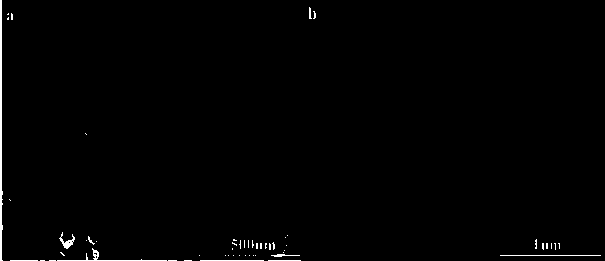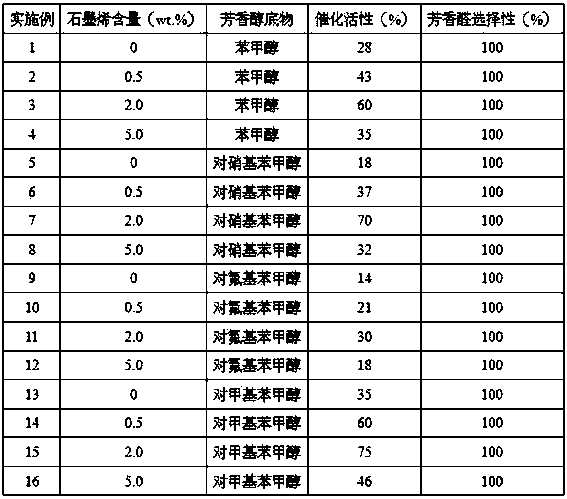Sandwiched Zr-MOFs (Metal-organic Frameworks)/graphene composite photocatalyst as well as preparation method and application thereof
A graphene composite and photocatalyst technology, applied in the direction of organic compound/hydride/coordination complex catalyst, physical/chemical process catalyst, organic compound preparation, etc., can solve the problem of graphene composite and reduce the conductivity of graphene efficiency and other issues, to achieve excellent photocatalytic performance, improve photocatalytic efficiency, and inhibit the effect of recombination
- Summary
- Abstract
- Description
- Claims
- Application Information
AI Technical Summary
Problems solved by technology
Method used
Image
Examples
Embodiment 1
[0029] Weigh 318 mg zirconium tetrachloride (ZrCl 4 ) and 245.2 mg of 2-aminoterephthalic acid (2-NH 2 -H 2 BDC), added to 150 ml of DMF (N,N'-dimethylformamide), stirred at room temperature at a stirring rate of 700 rpm for 60 minutes, and the solution obtained after stirring was transferred to a 50 ml autoclave in batches reaction in an oven at 120°C for 48 hours, after the time was up, take it out and cool it in the air to room temperature, centrifuge, exchange methanol for 5 days, and dry it in a vacuum oven at 80°C to obtain an amino group-containing Zr-MOF material. Weigh 25 mg of the prepared Zr-MOF material into a glass reactor, add 2.5 ml of pre-saturated benzotrifluoride and 0.5 mmol (50 microliters) of benzyl alcohol, seal it, and use a xenon lamp light source with a wavelength ≥ 420 nm 8 hours of light.
Embodiment 2
[0031] Take 1 milliliter of the aqueous phase dispersion of graphite oxide with a concentration of about 1.6 mg per milliliter in 150 milliliters of DMF (N,N'-dimethylformamide), and sonicate for 30-40 minutes to obtain a brown-yellow solution A; Add 14.3 mg of trimethyl-(2-oxo-2-pyrene-1-yl-ethyl)-ammonium bromide (pyrene + ), and then sonicated for 30-40 minutes to obtain a bright yellow solution B; add 245.2 mg of 2-aminoterephthalic acid (2-NH 2 -H 2 BDC), stirred overnight at room temperature; then added 318 mg of zirconium tetrachloride (ZrCl 4 ) and 245.2 mg of 2-aminoterephthalic acid (2-NH 2 -H 2 BDC), and then stirred at room temperature for 60 minutes at a stirring rate of 700 rpm; the solution obtained after stirring was transferred to a 50 ml high-pressure reactor in batches, and reacted in an oven at 120 ° C for 48 hours, and was taken out after the time was up. Cool to room temperature in the air, centrifuge, exchange methanol for 5 days, and dry in a vacuum...
Embodiment 3
[0033] Take 4 ml of the aqueous dispersion of graphite oxide with a concentration of about 1.6 mg per ml in 150 ml of DMF (N,N'-dimethylformamide), and sonicate for 30-40 minutes to obtain a brownish yellow solution A; Add 14.3 mg of 3-methyl(2-oxo-2-pyrene-1-yl-ethyl)ammonium bromide (pyrene + ), and then sonicated for 30-40 minutes to obtain a bright yellow solution B; add 245.2 mg of 2-aminoterephthalic acid (2-NH 2 -H 2 BDC), stirred overnight at room temperature; then added 318 mg of zirconium tetrachloride (ZrCl 4 ) and 245.2 mg of 2-aminoterephthalic acid (2-NH 2 -H 2 BDC), and then stirred at room temperature for 60 minutes at a stirring rate of 700 rpm; the solution obtained after stirring was transferred to a 50 ml high-pressure reactor in batches, and reacted in an oven at 120 ° C for 48 hours, and was taken out after the time was up. Cool to room temperature in the air, centrifuge, exchange methanol for 5 days, and dry in a vacuum oven at 80 °C to obtain a Zr-M...
PUM
 Login to View More
Login to View More Abstract
Description
Claims
Application Information
 Login to View More
Login to View More - R&D
- Intellectual Property
- Life Sciences
- Materials
- Tech Scout
- Unparalleled Data Quality
- Higher Quality Content
- 60% Fewer Hallucinations
Browse by: Latest US Patents, China's latest patents, Technical Efficacy Thesaurus, Application Domain, Technology Topic, Popular Technical Reports.
© 2025 PatSnap. All rights reserved.Legal|Privacy policy|Modern Slavery Act Transparency Statement|Sitemap|About US| Contact US: help@patsnap.com


